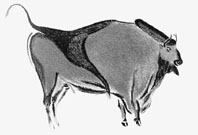

 | Page 81 |  |
Altamira contains a wealth of other paintings and engravings, including “masks” and quadrilateral signs like those of the cave of El Castillo in the same region. The two caves also contain identical multiple-line engravings of deer, both on the walls and on shoulder-blade bone of animal remains found in the cave, and some of these bones have been radiocarbon dated to 13,550 b.c. Altamira’s art probably spans a period from about 20,000 to 14,000 years ago. Charcoal from black figures in different parts of the cave has produced direct dates from 16,480 to 14,650 years ago.

Paleolithic cave painting from Altamira
(Ann Ronan Picture Library)
The ceiling is clearly a complex palimpsest of figures from different phases, but scholars from Sanz de Sautuola onward have believed that the polychrome bison were produced in one episode or even by a single artist. However, charcoal in some of the ceiling’s bison has yielded radiocarbon results from 14,820 to 13,130 years ago, which, if valid, suggests that the figures may not constitute a single homogeneous composition after all.
See also
The American Academy in Rome is the U.S. center in Rome for scholars, architects, artists, and musicians and incorporates a School of Classical Studies. Originally two separate schools—the American School of Architecture in Rome, founded in 1894 by Charles Follen McKim, and the American School of Classical Studies in Rome, established in 1895 by the archaeological institute of america (AIA)—the American Academy in Rome (AAR) became a single institution in 1912.
The architectural school had taken the French Academy in the grand Villa Medici in Rome as its model, and McKim had envisioned it as a center for architects to study the noble buildings of ancient Rome. Its first home was, however, anything but imperial, consisting of eight rented rooms in the Palazzo Torlonia. The classical school was the second such school the AIA founded, and its model was the American School of Classical Studies in Athens, established in 1882, also in emulation of older European institutions. The Rome classical school, too, began life in rented quarters—in the Villa Aurora on the Pincio Hill.
The two American schools in Rome moved from their separate quarters to a new building on the Janiculum Hill in 1914. This main building, together with the neighboring Villa Aurelia (a 1909 bequest to the architectural school) and several other buildings, is the home of the AAR to this day, and the complex houses a research library, art studios, music rooms, exhibition galleries, and residential and dining facilities. The American Academy in Rome is unique among the many foreign schools in that city because of its status as a privately funded organization and its diverse Rome Prize fellowship program that brings together archaeologists, philologists, historians, art historians, architects, painters, sculptors, and musicians to form a vibrant intellectual and artistic community.
Unlike its sister institution in Greece, the American School of Classical Studies in Rome was unable to undertake any excavations in Italy for half a century after its foundation. Its members consequently confined their activities to the study of architecture, topography, inscriptions, and classical statuary. Among the noteworthy studies produced during the AAR’s early years were Esther Van Deman’s on Roman construction techniques and Samuel Ball Platner’s on Roman topography.
It was not until after World War II that a more receptive attitude in Italy toward foreign excavation permitted members of the AAR to begin major fieldwork. In 1948, under the direction of
 |  |